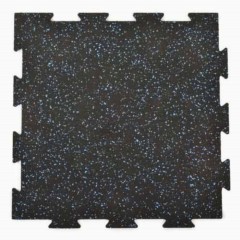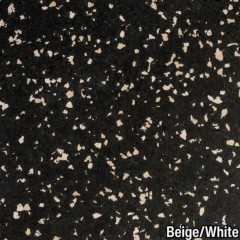Whether constructing playground flooring for use outdoors, a weightlifting room indoors, or anything in between where durability is a must, trust the quality of interlocking rubber floor tiles from Greatmats.
We offer a wide range of sizes of tiles, ensuring that customers can find just the right model. We also offer many colors beyond the basic black color traditionally found with these mats, ensuring customers can create the perfect look and feel for the space.
Size and Shape Options
Interlocking rubber floor tiles are a specialty of Greatmats, as we offer dozens of different sizes and thicknesses of these mats.
Some of our mats are as thin as
8mm (or about 5/16 inches), while others are as thick as
5 inches. Thicker rubber tiles will deliver a higher level of cushioning and durability than thinner tiles, but they also weigh quite a bit more, which can complicate installation.
Thicker tiles are a necessity in a commercial gym or in a converted basement or garage at home where heavy barbells and weightlifting machines will be in use. The rubber protects the subfloor from damage from heavy weight. The rubber will not indent under the weight of bulky machines, either.
The majority of tiles have rough dimensions of 24x24 inches or 36x36 inches. However, we do offer some
4x6 foot tiles.
Customers may lose a little bit of the expected square footage in the coverage area from the interlocking edges on the tiles, depending on the design of the edges.
Material Options
The majority of our interlocking rubber floor tiles contain recycled rubber material. These rubber crumbs are completely safe to use as flooring, even around children and pets. This is not a cheap material, as it will deliver the same properties as virgin rubber flooring.
We source most of our tiles from manufacturers in the United States. This gives our customers peace of mind about the quality of the manufacturing process. These interlocking rubber floor tiles will not have weak spots that could affect the integrity of the floor.
By making use of recycled rubber, these tiles give rubber products, such as old tires, a new life, keeping them out of landfills.
Additionally, the manufacturers follow precise measurement tolerances. Customers will not have a tile that has an overly thick spot or an interlocking edge that doesn’t fit into an adjacent tile because of a measurement error.
Pattern and Texture Options
Because of its anti-slip properties, rubber is one of the best types of flooring to use in areas where dampness may be present. Manufacturers do not need to add molded, textured patterns to the surface of the interlocking rubber floor tiles to create extra traction, although some models do have grooved patterns.
The majority of interlocking rubber floor tiles have a black base color. Some tiles only appear in an all-black color.
Other models, however, offer colors beyond black that create an interesting and unexpected design in the flooring. Some tiles will have colored flecks of rubber molded into the black base color in a 10% concentration or in a higher concentration.
A few models consist of a solid color other than black, especially tiles used for children’s playgrounds.
Common Use Options
Rubber tiling is highly versatile, meaning customers can install it in many different locations successfully.
For an
outdoor rubber tile installation, some people use it over the top of a playground area. The rubber has some flex to it, allowing it to fit easily over an uneven surface. It also protects kids in the event of a fall far more effectively than bare gravel or concrete. Rubber tiles work well over patio seating areas too.
Indoors, rubber floors commonly appear in commercial and home gymnasiums. They cut down on noise from strenuous workouts while protecting the subfloor from heavy athletic equipment.
Installation Options
Because of the interlocking edges on all four sides of these tiles, customers simply line up the connecting edges and pop them together. Some tiles require adhesive on the edges to hold them together, while others simply hold tight without adding glue.
The significant weight of these tiles means that they often remain in place without sliding around in a dry lay installation. For some types of tiles, though, the manufacturer recommends gluing them to the subfloor to ensure a sturdy, permanent installation.
Some tiles work well for DIY installation by novices, while others may require hiring a professional installer.
Cleaning and Maintenance Requirements
To clean our rubber flooring, start by removing dust and other dry debris on a regular basis. Use a vacuum cleaner, a leaf blower, or a broom to remove items that could lead to staining if left on the surface of the rubber.
For a more detailed cleaning, customers can add a neutral pH cleaning product to warm water. Then apply the mixture with a mop. You may want to use a clean water bucket to rinse the mop to keep the cleaning solution as clean as possible. Allow the area to naturally dry in the air over a couple of hours.
 $1332 /Tile You Save 19%$3.43/sqftShips Out in 7-10 Working Days SustainableShop$1243 /Tile You Save 20%$3.20/sqftShips Out in 7-10 Working Days SustainableShop$1042 /Tile You Save 19%$2.69/sqftShips Out in 7-10 Working Days SustainableShop
$1332 /Tile You Save 19%$3.43/sqftShips Out in 7-10 Working Days SustainableShop$1243 /Tile You Save 20%$3.20/sqftShips Out in 7-10 Working Days SustainableShop$1042 /Tile You Save 19%$2.69/sqftShips Out in 7-10 Working Days SustainableShop1 reviews •18 Colors
$1332 /Tile You Save 19%$3.43/sqftShips Out in 7-10 Working Days SustainableShop$1243 /Tile You Save 20%$3.20/sqftShips Out in 7-10 Working Days SustainableShop$1640 /Tile You Save 20%$4.23/sqftShips Out in 7-10 Working Days SustainableShop$1042 /Tile You Save 19%$2.69/sqftShips Out in 7-10 Working Days SustainableShop$1332 /Tile You Save 19%$3.43/sqftShips Out in 7-10 Working Days SustainableShop$1243 /Tile You Save 20%$3.20/sqftShips Out in 7-10 Working Days SustainableShop$1640 /Tile You Save 20%$4.23/sqftShips Out in 7-10 Working Days SustainableShop$1640 /Tile You Save 20%$4.23/sqftShips Out in 7-10 Working Days SustainableShop$1474 /Tile You Save 20%$3.80/sqftShips Out in 7-10 Working Days SustainableShop$959 /Tile You Save 20%$2.47/sqftShips Out in 7-10 Working Days SustainableShop$1184 /Tile You Save 20%$3.05/sqftShips Out in 7-10 Working Days SustainableShop$1107 /Tile You Save 20%$2.85/sqftShips Out in 7-10 Working Days SustainableShop$900 /Tile You Save 20%$2.32/sqftShips Out in 7-10 Working Days SustainableShop




































































